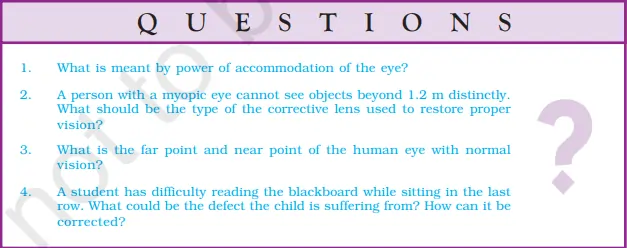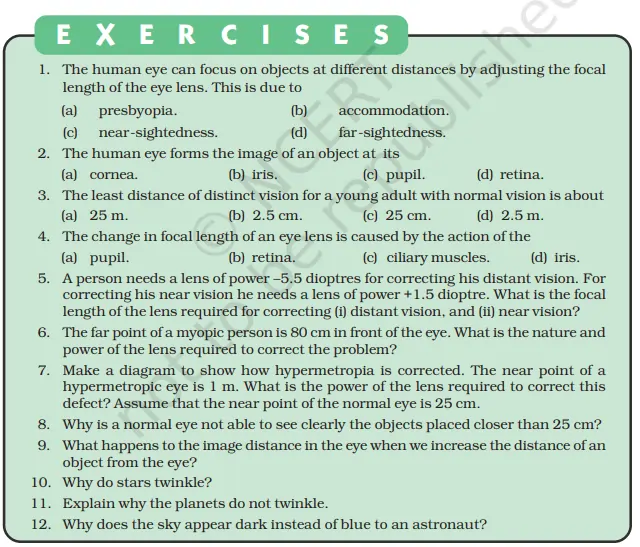In the 2023-24 CBSE syllabus, Human Eye and Colourful World chapter is now Chapter 10.
NCERT Solutions for Class 10 Science Chapter 10, “The Human Eye and Colourful World” rationalised important for students to prepare for exams and score better as it has greater weightage in Board 2024. It covers topics like eye accommodation, vision problems, and light dispersion.
These solutions are designed for easy understanding, making them useful for CBSE and other state board exam. They are available online and in PDF format for easy access.
The complete solution contains in lesson/ in-text QUESTIONs and EXERCISE.
NCERT Solution Class 10 Rationalised Chapter 10 Human Eye and Colourful World
Chapter 10: Rationalized Syllabus – The Human Eye and the Colourful World
10.1 The Human Eye
- Significance of the Human Eye
- Structure and Function
- Power of Accommodation
- Eye Lens
10.2 Defects of Vision and their Correction
- Common Refractive Defects
- Myopia, Hypermetropia, Presbyopia
- Correction with Spherical Lenses
10.3 Refraction of Light Through a Prism
- Refraction in a Glass Slab
- Emergent Ray and Incident Ray
- Refraction through a Triangular Prism
10.4 Dispersion of White Light by a Glass Prism
- Explaining Rainbow Formation
- Activity on Refraction through a Prism
- Reason Behind Light Dispersion
10.5 Atmospheric Refraction
- Understanding Atmospheric Refraction
- Relationship with Star Twinkling
- Effects on Sunrise and Sunset
10.6 Scattering of Light
- Scattering in Colloidal Particles
- Visibility in Colloidal Solutions
- Tyndall Effect and Sky Color
- Sun’s Color at Sunrise and Sunset
Also Takes Notes:
Rationalised Human Eye and Colourful World In-Text Solution 2024
This chapter has four in-text question which are important for both understanding chapter and for exam. Below we have provided their solutions:

1.What is meant by power of accommodation of the eye?
- The power of accommodation of the eye refers to the ability of the eye’s lens to change its focal length to focus on objects at different distances.
- This adjustment is achieved through the contraction and relaxation of the ciliary muscles, which change the shape of the lens.
- For examples; When you shift your gaze from a nearby book to a distant object, your eye’s lens changes its shape to bring the distant object into focus.
2. A person with a myopic eye cannot see objects beyond 1.2 m distinctly. What should be the type of the corrective lens used to restore proper vision?
An individual with myopia should use a concave lens with a focal length of 1.2 meters to restore proper vision because:
- Myopia causes distant objects to appear blurry as light converges in front of the retina.
- A concave lens, being divergent, disperses incoming light rays.
- By using a concave lens with a focal length of 1.2 meters, the lens helps the eye focus distant objects at that specific distance, allowing for clear vision.
| Defect | Myopia (Nearsightedness) |
|---|---|
| Corrective Lens Type | Concave Lens (Diverging Lens) |
| Power of Lens | Negative Power |
| Power Calculation | Lens Power (in diopters) = 1 / Focal Length (in meters) |
| For a near point of 1.2 m, the lens power ≈ -0.83 diopters |
3. What is the far point and near point of the human eye with normal vision?
- Far Point: The far point of the eye is the maximum distance at which an object can be seen clearly without any strain. For a normal eye, it is considered to be at infinity (∞).
- Near Point: The near point of the eye is the minimum distance at which an object can be seen clearly without any strain. For a normal eye, it is typically around 25 cm.
| Aspect | Far Point | Near Point |
|---|---|---|
| Definition | Maximum distance for clear vision without strain | Minimum distance for clear vision without strain |
| Normal Eye | Considered to be at infinity (∞) | Typically around 25 cm |
| Significance | Determines the eye’s ability to see distant objects | Determines the eye’s ability to see nearby objects |
4. A student has difficulty reading the blackboard while sitting in the last row. What could be the defect the child is suffering from? How can it be corrected?
- Defect: The student is likely suffering from myopia (nearsightedness).
- Correction: To correct myopia, the student should use a concave lens with the appropriate power. The lens will help diverge the incoming light rays and bring the distant blackboard into focus, allowing the student to see it clearly.
NCERT Solution For Class 10 Chapter 10 Human Eye and Colourful World Exercise 2024

1. The human eye can focus on objects at different distances by adjusting the focal length of the eye lens. This is due to:
(a) presbyopia.
(b) accommodation.
(c) near-sightedness.
(d) far-sightedness.
Answer: (b) accommodation.
2. The human eye forms the image of an object at its:
(a) cornea.
(b) iris.
(c) pupil.
(d) retina.
Answer: (d) retina.
3. The least distance of distinct vision for a young adult with normal vision is about:
(a) 25 m.
(b) 2.5 cm.
(c) 25 cm.
(d) 2.5 m.
Answer: (c) 25 cm.
4. The change in focal length of an eye lens is caused by the action of the:
(a) pupil.
(b) retina.
(c) ciliary muscles.
(d) iris.
Answer: (c) ciliary muscles.
5. A person needs a lens of power –5.5 dioptres for correcting his distant vision. For correcting his near vision he needs a lens of power +1.5 dioptre. What is the focal length of the lens required for correcting (i) distant vision, and (ii) near vision?
(i) Focal length for distant vision = 1 / (Power for distant vision) = 1 / (-5.5 D) ≈ -0.182 meters ≈ -18.2 cm (negative sign indicates it’s a diverging lens).
(ii) Focal length for near vision = 1 / (Power for near vision) = 1 / (+1.5 D) ≈ 0.667 meters ≈ 66.7 cm.
6. The far point of a myopic person is 80 cm in front of the eye. What is the nature and power of the lens required to correct the problem?
Nature: A myopic eye needs a concave (diverging) lens to correct the problem.
Power = 1 / (Focal length) = 1 / (-0.8 m) ≈ -1.25 dioptres.
7. Make a diagram to show how hypermetropia is corrected. The near point of a hypermetropic eye is 1 m. What is the power of the lens required to correct this defect? Assume that the near point of the normal eye is 25 cm.

Power = 1 / (Focal length) = 1 / (1 m – 0.25 m) = 1 / (0.75 m) ≈ +1.33 dioptres (convex lens needed).
8. Why is a normal eye not able to see clearly the objects placed closer than 25 cm?
- A normal eye has a near point of 25 cm.
- The near point is the closest distance at which the eye can focus on an object clearly.
- Beyond this point, the ciliary muscles, responsible for changing the shape of the eye lens to focus, cannot further increase the curvature of the lens.
- This inability to increase lens curvature prevents the eye from bringing objects closer than 25 cm into clear focus.
9. What happens to the image distance in the eye when we increase the distance of an object from the eye?
- When an object is moved farther away from the eye, the image distance in the eye increases.
- As the object moves away, the ciliary muscles relax, allowing the eye lens to become flatter.
- The flatter lens causes light rays from the distant object to converge at a point closer to the retina.
- This adjustment ensures that the image forms on the retina, resulting in a clear and focused image.
10. Why do stars twinkle?
- Stars twinkle due to the atmospheric phenomenon known as atmospheric refraction.
- Earth’s atmosphere consists of different layers of air with varying temperatures and densities.
- These layers act as lenses, refracting or bending the starlight as it passes through them.
- The refraction causes the apparent position and brightness of the star to fluctuate rapidly, creating the twinkling effect.
11. Explain why the planets do not twinkle.
- Planets do not twinkle as prominently as stars because they appear larger in the night sky.
- Unlike point-like stars, planets have a finite size and an apparent disk.
- This larger apparent size makes the effects of atmospheric turbulence less noticeable, resulting in a steadier appearance.
- Planets’ extended shape helps average out the distortion caused by atmospheric layers, reducing the twinkling effect.
12. Why does the sky appear dark instead of blue to an astronaut?
- The sky appears dark instead of blue to an astronaut in space because there is no atmosphere to scatter sunlight.
- On Earth, the blue appearance of the sky is due to Rayleigh scattering, where shorter wavelengths (blue and violet) of light are scattered in all directions by atmospheric particles.
- In space, without an atmosphere, there is no scattering of light.
- As a result, sunlight does not scatter in all directions, and there is no redirection of light toward the observer, making the sky appear dark.

